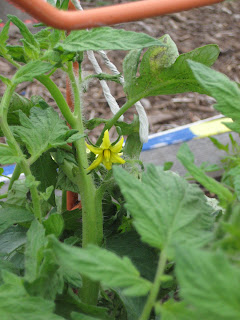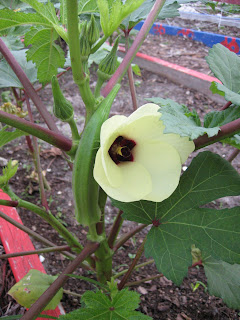“I go to nature to be soothed and healed, and to have my senses put in tune once more.” –John Burroughs
After another weekend, the garden continues to surprise us with beauty. When examining the first bed with the tomatoes in it I notice that quite a few tomatoes have been planted since I had last been there. The biggest one in the bed continues to grow. We were excited to find that it has a few yellow flowers that have recently bloomed.
I did some weeding and thinning out in the carrot bed, between the sweet potatoes and tomatoes. I noticed that the sweet potatoes also have flowers that are a white and purple growing within its leaves. These flowers are not easy to see because they are hidden by the big leaves.
Other excitement in the garden was in the pole bean bed. The bean’s long spiral tendrils finally decided to climb up the pole. It won’t be long till the other beans do the same.
Mrs. Barlow’s kindergarten class came out around nine-thirty. We asked them how their bean plants were doing that they planted last week and if they noticed any changes. They said they had seen some green in the cups. We then introduced our topic of the Lesson, “Plants have Parts”. Using a chalkboard with a stem drawn on it and paper cutouts of pictures and labels of the other parts, we had them attach various parts of the plant (roots, leaves, flower, and fruit) to the diagram. We reviewed all the parts again and went over their various functions. Roots are like a sponge; they absorb water and nutrients and hold food. The stem is like a straw sucking up water while the leaf lays out to collect sun and food. The flower and fruit holds the seeds for new plants to grow. We told them to draw a picture of all the plant parts, using the plants in our garden. The okra turned out to be the best example because it had a flower and fruit.
The radishes are nearly ready for harvesting so we decided to pull one up to show the kids some roots. They were amazed by how much of the plant was hidden in the soil.
The kids lined up and got ready to go back to the classroom. It seems like they would much rather prefer to stay in the garden and I can understand why. Everything is growing and it is exciting to be part of the process!
Julia Melton
Welcome! This blog follows the building, cultivating, and harvesting of the Lakewood Elementary schoolyard garden in St. Petersburg, Florida. Since January 2009, the Edible Peace Patch Project has been developing innovative community-oriented food system and nutrition educational programs in south St. Petersburg, Florida. Lakewood Elementary is the 1st school to participate in our Garden Education Program!






I was happy to meet you at the garden yesterday.
ReplyDeletePlease pass the word about our outreach to parents who live in Bartlett Park. Try to bring a parent or teacher to our meeting this Thursday.
When we find a better way to connect parents with their school and the resources their kids need they will do better in school.
This will be followed by a summit on Nov 5th, training and door to door contact with parents. Parents who were involved with the garden are the best people to reach other parents.
http://www.bartlettpark.net/2011/10/church-summit-3-theme-church-increasing.html